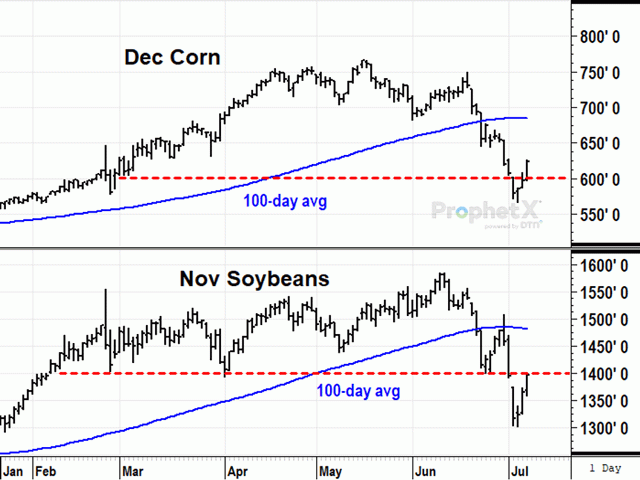Todd's Take
Late-Week Buying Reminds Corn Speculators of Bullish Risks Ahead
According to Friday's Commitments of Traders data, noncommercial net longs in corn fell 67,397 in the week ended July 5 to 260,705. The last time speculative positions in corn were this small, corn harvest was just starting in 2021, and December 2022 corn was going for $5.02 a bushel.
The latest spec position is just over half as large as it was in early May when December corn was trading at $7.35. On Friday, July 8, December corn closed at $6.23 1/2, and we know a little more about this year's U.S. corn crop, but the big risks are still ahead.
According to USDA, U.S. farmers planted 89.9 million acres to corn in 2022, the smallest area in three years. Because early planting conditions were wet and planting was slower than usual in the Dakotas and Minnesota, USDA will take a second survey in July for those three states and update the national estimate on Aug. 12, if needed. Tuesday's WASDE report will probably estimate a roughly 14.5-billion-bushel (bb) corn crop, based on a record yield of 177 bushels per acre, but it is yield where the big questions have yet to be answered.
When USDA's first crop rating for corn was released on June 6, 73% of the crop was considered either good or excellent, and topsoil moisture was adequate or, in some cases, too much across the bulk of the Corn Belt. Eastern North Dakota and northwestern Minnesota were the areas of greatest concern. According to USDA, 4.0 million acres of corn were not yet planted when the June Acreage survey was taken.
As of July 3, only 64% of the corn crop is rated good to excellent, tied with last year for the third-lowest rating since 2010 as the crop has endured stretches of dry weather, punctuated by local rains.
Rain in the forecast in front of the July 4 weekend encouraged some of the noncommercial selling in Friday's report, but the main push behind specs getting out of corn has been inspired by investors' worries over the economy. A steady drumbeat of inflation news, talk of higher interest rates and worries about possible recessions have all had a big impact in shaking speculators out of corn, soybean and wheat markets, especially since mid-May.
P[L1] D[0x0] M[300x250] OOP[F] ADUNIT[] T[]
Bearish pressure on corn prices has also come from Brazil, where the second corn harvest is nearing the halfway mark. Early reports have been better than expected, and on July 5, Brazil's crop agency, Conab, estimated record-high corn production of 115.7 million metric tons or 4.55 bb in 2021-22. Related to the anticipation of the southern harvest, U.S. corn export sales have dropped off lately and even posted 2.6 million bushels (mb) of canceled sales in Friday's weekly report from USDA.
But as I mentioned earlier, the question of U.S. yield is still on the table, and clues started looking more bullish late last week. While actual rain coverage was fairly impressive the past seven days, ignoring the severe weather and damaging winds, the forecast for the next two weeks is noticeably drier as more corn enters pollination. By July 15, the weather is also expected to turn hotter, adding to crop stress.
As I've mentioned often in daily market comments, DTN meteorologists also have a hot and dry forecast for August and September, which, if proved true, will further threaten not only corn yields but soybeans and spring wheat also.
It is also important we don't forget about Ukraine, one of the world's most important exporters of corn, wheat, barley and sunflowers. As specs were waking up to a steady diet of bearish news about the economy the past several weeks and bailing out of long positions in corn, soybeans and wheat, I doubt they were giving much consideration to long-term weather forecasts or Russia's relentless assault on this vital region.
USDA currently anticipates Ukraine will be able to export 27% of the corn and 41% of the wheat that was expected from the country before the war began, and those estimates will be updated Tuesday. Another concern, however, is that Russia could target sites of harvested grain once the grain has been gathered.
Ukraine's winter wheat harvest is about to begin, and we will soon find out Russia's plans. It has not been encouraging to see numerous photos on Twitter this past week of mature wheat fields set on fire, presumably by Russian troops.
For many reading this column, you probably already know my view that markets are people, people are emotional and speculators, in particular, tend to follow the crowd, right or wrong. In this case, I believe the specs took corn, soybean and wheat prices too low on July 5, as there are plenty of bullish risks left in this market.
Unless Russia steals the spotlight, weather will be the dominant concern for the remainder of the 2022 crop season. From the view here on July 11, corn yield estimates in late July are about to come down, possibly followed by soybean yield estimates in August. At that point, specs may want some of those long trades back, but they'll have to pay up to get them.
**
Comments above are for educational purposes only and are not meant as specific trade recommendations. The buying and selling of grain or grain futures or options involve substantial risk and are not suitable for everyone.
Todd Hultman can be reached at Todd.Hultman@dtn.com
Follow him on Twitter @ToddHultman1
(c) Copyright 2022 DTN, LLC. All rights reserved.




